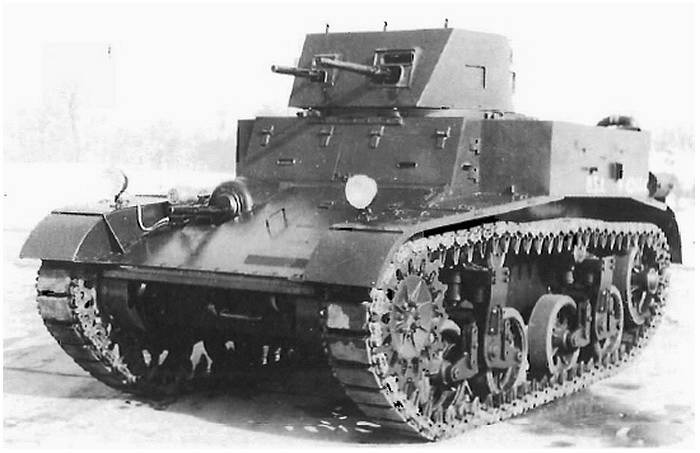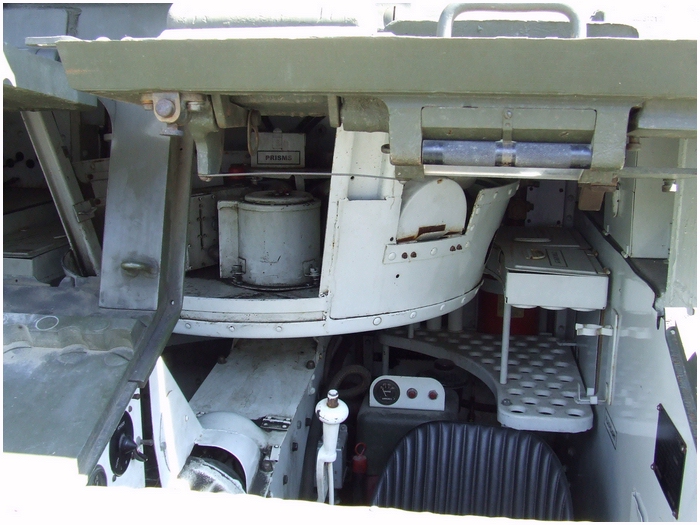
Preface
There is no doubt that the M4 Sherman was the best known tank for the Allies in the Second World War.
But the light tank, M3 and M5 belongs on the list as an important tank.
After the First World War the Tank Corps was decommissioned in 1919 by order of the General Staff. In 1920,
under the National Defense Act, it was decided that tanks would operate under the infantry. Because of economical
and operational reasons there was only thoughts for a 'Light' and a 'Medium' weight tank. The Light tank would be
5 ton (for transport by lorry) and the 15 ton Medium tank was not to heavy for the (military) bridges it had to cross.

The Light Tank T2
Because of the restrictions that only the infantry could use tanks, the US. Cavalry looked for possibilities
to get tanks as well. In 1931 General Douglas MacArthur talked the Army into the use of 'Combat Cars' for the
cavalry ('tanks' would be exclusive for the infantry). Around 1934-35 a couple of experimental light tanks were
produced, the T2, T2E1 and the T2E2. This would lead for the cavalry to the T5. The T5 was further developed into the T5E2, that became the M1 Combat Car (are you still with me?)
The M1 had a 7 cylinder Continental W670 radial engine. The turret had a .50 and a .30 inch caliber machinegun.
There was an additional .30 at the front of the hull.

A Light Tank M1
The next version, the M2 had improved maneuverability. In July, 1940 a new Armored Force was founded
and the development went from then hand in hand between the infantry and the cavalry, and the 'Combat Cars' were
from then on 'tanks'. The M1 and the M2 became the M1A1 and the M1A2. These light tanks saw never action, but
were important in training crews and further development. Main engine for the M2A2E3 and the M2A3E3 became the
Guiberson diesel engine which gave the vehicle a greater radius.

An M2A3, this type never saw action
The last of the M2 series,
the M2A4 got a 37mm canon in the turret. An order for 329 tanks was given to the American
Car Foundry in October, 1939. The first was delivered in April, 1940. The order was extended to
365 vehicles, the last was delivered in March, 1941. The M2A4 was deployed in the Pacific Ocean,
but was mainly used as trainer vehicle.

An M2A4, the features of the M3 are
already showing
Light Tank M3
Stuart
The Light Tank M3 was a further development of the concept M1 and had still the Continental W670 as engine. The armor became thicker.
To compensate the weight, the suspension had to be built stronger. The older version had still 'gunports'
in the turret, in the M3 these were abandoned. In March, 1941, the M3 went into production again at the
American Car Foundry. During the production adjustments were made, such as a whole welded turret instead of
the riveted one. This was a great step forward in reducing the weight without losing armor thickness.
Half way 1941 the canon got a stabilizer.

An M3, notice the 'cupola' on top of the turret
The British Army used the M3 in North Africa under the name 'Stuart' Mk I.
They made some important adjustments, such as the additional fuel tanks that could be jettisoned, larger fenders and
smokepots on the turret. The name 'Stuart', used by the Brits, was not the only one,… crews named her affectionately
'Honey'. The American crews had no special name for her, other than abusive ones because of the cramped space in
the vehicle.

An M3 Stuart 1, notice the welded turret and the mudguards
There were 5811 M3's produced until January 1943. Of these, 1834 went to the British
army who deployed the little tank mostly in Africa. The Soviet Union's Red Army got 1336 M3's.
Because of the demand of the aircraft industry for the Continental engines, 1285 M3's were delivered
with the Guiberson T1020 diesel engine.
Light Tank M3A1
Stuart I t/m IV

A preserved M3A1
A important improvement led to the M3A1. The turret was completely redeveloped. It lost the extra
cupola and could rotate electrically. The new turret got an internal basket for the crew to sit in. In the previous
models, the crew, loader and gunner,
had to 'walk' with the turret when it was in motion and had to step over the crankshaft housing.

The turret basket in an M3A1
Until the introduction of the turret basket, it was common to maneuver the complete tank in the direction of fire.
But not every crew was happy with the 'basket', the space was more cramped and often the crew removed it.

The turret of an M3A1 from behind, with on top the two
hatches, front left on the
picture is the mounting for the antenna and right the point for the .30 machinegun,
also noticeable are the so called pistolports on the side and back.
Later models of the M3A1 lost the two extra machineguns sideways in the hull, that were remotely
operated by the driver in the M2A4 and the M3. They were of limited use and the Brits had removed
them mostly already in the predecessors. From the 4621 M3A1 built, 1594 went to the British and
1676 went to the Soviet Union. A total of 4410 M3A1's had the Continetal and 211 had the Guiberson diesel engine.

An M3A1 for moving in high water (developed for D-Day),
with a high
chimney for air- and fume exhaust (at the back), and engine cooling (front)
There were no M3A2 produced, and the chassis from the M3A3
would be used to develop the M5,
see the next page:
|